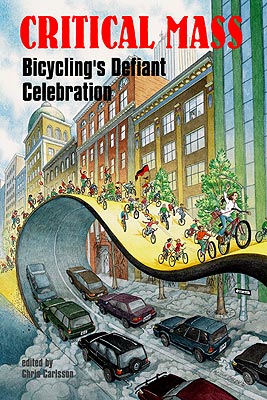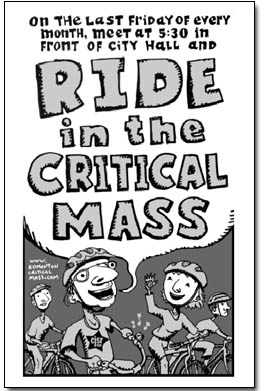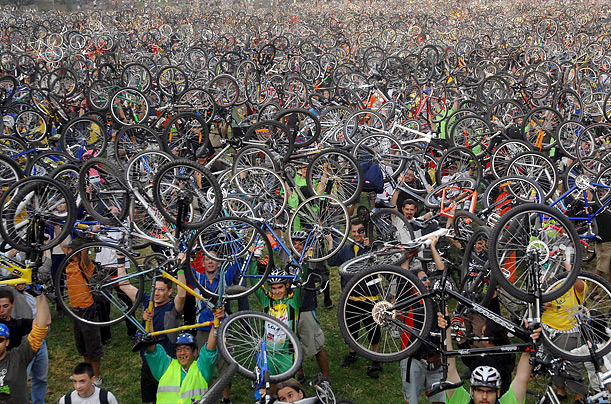 Cover of Chris Carlsson's book
Cover of Chris Carlsson's book
Critical mass, defined by the Merriam-Webster Dictionary, adheres to its intuitive breakdown of comprising words—a size, number, or amount large enough to produce a particular result. In the world of cycling, however, it means quite a lot more, while, paradoxically, not really meaning one particular thing at all. Here are some thoughts on the term from a range of active members in this movement compiled from a collection of essays in Chris Carlsson’s “Critical Mass: Bicycling’s Defiant Celebration”:
“not a protest but a demonstration of social space” -Anna Sojourner
“a positive urban vision of cycle-dominated streets” Michael Burton
“a catalyst for individuals and groups to network and build relationships based on common interests. It is a public meeting where most everybody can attend.” – Anonymous
“a movement to assert and celebrate the bicycle’s place in a modern eco-city, and the environmental arguments for greater bicycle accommodation.” -Joshua Switzky
In hundreds of cities around the world, monthly events are “organized” where cyclists of all kinds, beginning in a specified location, take over the streets. The reason I hesitate to use the term organize is because there really is no single coordinating group or individual. The term xerocracy has been coined to describe the process of advertising and publicizing for Critical Mass. You can see an example of one of the posters that is placed all around the city below. They use catchy slogans such as “get off you assphalt. Celebrate your bike,” “bicycles aren’t in the way, they are the way,” and “come join the pedal-powered party! Bring your momentum.”
 fotobywes.blogspot.com
fotobywes.blogspot.com
This event, generally held on a Friday, intentionally blocks rush hour traffic, drawing attention to the bicyclists and their causes. The intentions of each rider may vary, but they come together to use the bicycle to make a statement, ranging from oil independence to a stronger social bicycle community. It is because there is such little tangible, defined record of what a critical mass is and what it is for, that the gathering is able to straddle so many boundaries. It is the unique paradox of a completely public, non-hierarchical event that makes this monthly event so powerful. It is rare that this extent of anarchy can maintain such a clear and effective message.
What began in 1992 in San Francisco as a small constituency has grown in some cities to thousands of riders, young and old, experienced and amateurs. Participants usually report a feeling of empowerment and excitement upon being in the midst of such a stream of human-powered vehicles. A bicycle on the city streets usually feels vulnerable, threatened and the minority by car-focused infrastructure. This monthly role-reversal creates vivacity in being granted the rights that, the other 30 days of the month, seem worthy of a dream. This individual power is combined with a collective unconscious and the slew of other psychological phenomenon of groupthink. This sometimes results in dangerous and illegal behavior, which has given Critical Mass a bad reputation. When the police aren't arresting individuals, they are ironically facilitating the mass.
In order to create a successful vision of a future filled with bicycles, a delicate balance must be achieved during a critical mass. It is easy to fall into a bikes versus cars mentality as hundreds of bicycles speed through red lights as cars back up awaiting for the dissipation of the organized chaos. Rather than fueling road rage, critical mass can foster its gathering towards an exposure to not only the problems of car-dependence, but possible practical solutions, serving as a vision for the future.
Critical Mass exists in various forms, ranging in participation, extremity, and acceptance—but all with the same message of bicycle acceptance. The World Naked Bike Ride is an example of Critical Mass taken to the next level.
 Time Magazine, European Car Free Day in Budapest, Hungary
Time Magazine, European Car Free Day in Budapest, Hungary
Back to The Bicycle home page
